Analysis of Business Communication Barriers in London Underground
VerifiedAdded on 2023/01/10
|9
|2064
|74
Report
AI Summary
This report delves into the realm of business communication, providing a comprehensive overview of organizational communication theories, including formal, informal, oral, written, internal, and external communication. It then focuses on communication practices within the context of the London Underground, specifically analyzing the barriers encountered by Londoners and tourists. These barriers include emotional and language differences, which hinder effective communication. The report identifies specific communication principles, such as clarity and attention, and recommends strategies to overcome these challenges, fostering improved interactions. The analysis draws on various sources to support its findings and recommendations, ultimately aiming to enhance communication effectiveness in the London Underground environment. The report also includes the application of effective communication principles to improve practices and identify strategies to overcome barriers relevant to the London Underground, concluding with a summary of the key findings and recommendations.
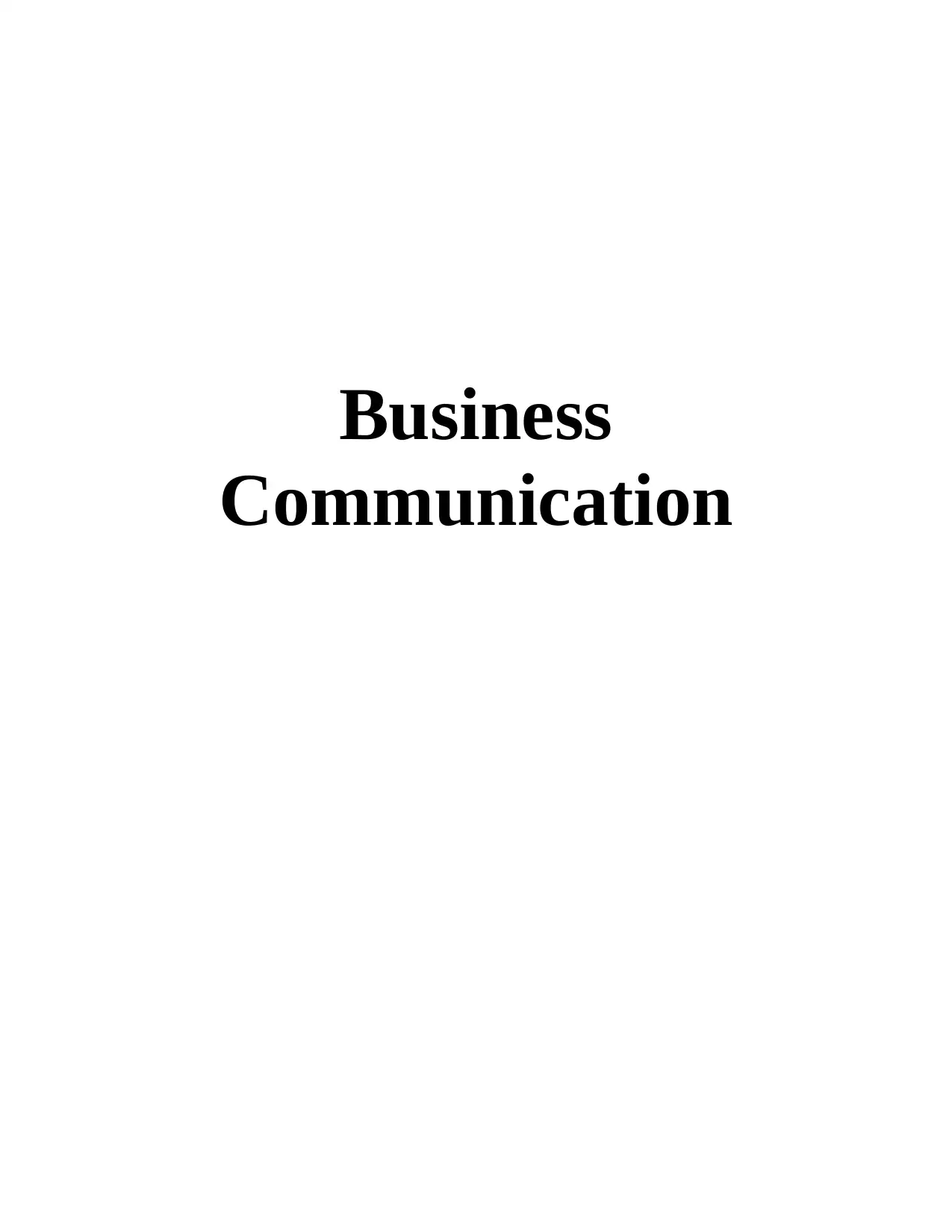
Business
Communication
Communication
Paraphrase This Document
Need a fresh take? Get an instant paraphrase of this document with our AI Paraphraser

ABSTRACT
Business communication is basically referring to exchanging information and sensitive data from
one person to another or in numerous parties. Business communication is conducted in order to
promote organisations goals, agendas, aims and activities which the purpose of increasing profits
and surviving in the marketplace. The project also conducts discussion upon business
communication activities along with highlighting several barriers which exist in London
underground. More over strategies and principles of communications are suggested for
improving the relationship between Londoners and tourists with the help of better
communication practices.
Business communication is basically referring to exchanging information and sensitive data from
one person to another or in numerous parties. Business communication is conducted in order to
promote organisations goals, agendas, aims and activities which the purpose of increasing profits
and surviving in the marketplace. The project also conducts discussion upon business
communication activities along with highlighting several barriers which exist in London
underground. More over strategies and principles of communications are suggested for
improving the relationship between Londoners and tourists with the help of better
communication practices.
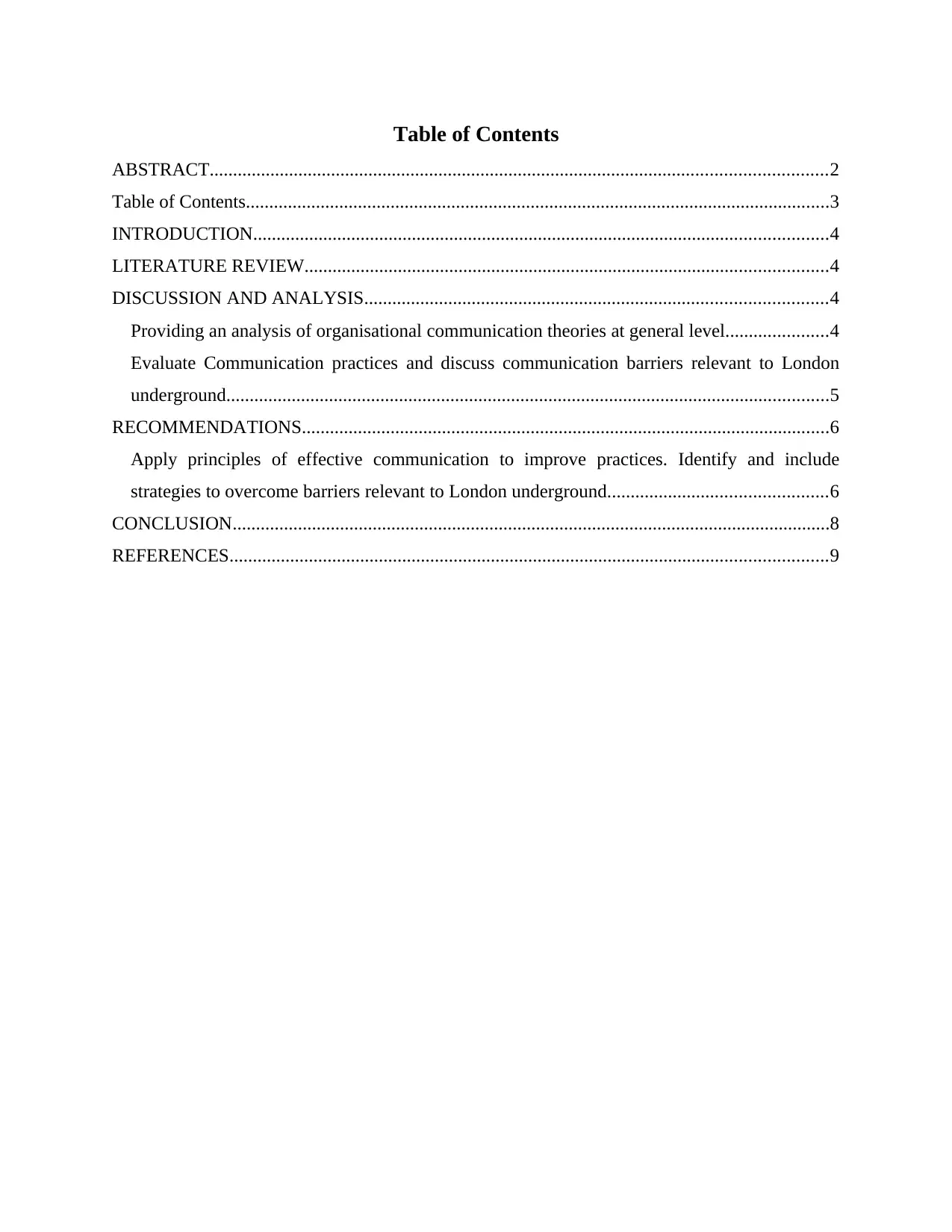
Table of Contents
ABSTRACT....................................................................................................................................2
Table of Contents.............................................................................................................................3
INTRODUCTION...........................................................................................................................4
LITERATURE REVIEW................................................................................................................4
DISCUSSION AND ANALYSIS...................................................................................................4
Providing an analysis of organisational communication theories at general level......................4
Evaluate Communication practices and discuss communication barriers relevant to London
underground.................................................................................................................................5
RECOMMENDATIONS.................................................................................................................6
Apply principles of effective communication to improve practices. Identify and include
strategies to overcome barriers relevant to London underground...............................................6
CONCLUSION................................................................................................................................8
REFERENCES................................................................................................................................9
ABSTRACT....................................................................................................................................2
Table of Contents.............................................................................................................................3
INTRODUCTION...........................................................................................................................4
LITERATURE REVIEW................................................................................................................4
DISCUSSION AND ANALYSIS...................................................................................................4
Providing an analysis of organisational communication theories at general level......................4
Evaluate Communication practices and discuss communication barriers relevant to London
underground.................................................................................................................................5
RECOMMENDATIONS.................................................................................................................6
Apply principles of effective communication to improve practices. Identify and include
strategies to overcome barriers relevant to London underground...............................................6
CONCLUSION................................................................................................................................8
REFERENCES................................................................................................................................9
⊘ This is a preview!⊘
Do you want full access?
Subscribe today to unlock all pages.

Trusted by 1+ million students worldwide

INTRODUCTION
Communication is a tool for exchanging information and viewpoints which is used by
people around the globe in their day to day activities to share particular information in the most
effective and efficient manner (Killingsworth and Gilbertson, 2018). The current report is
focused over developing and understanding about organisational communication theories along
with discuss in communication barriers and effective practices that are useful for the people
travelling in London underground. At the end recommendations are provided with the help of
effective principles of communication for overcoming the barriers of communication.
LITERATURE REVIEW
According to several authors and researchers organisational communication is defined as
channels and forms of communication that occurs within a company such as a corporation, a
non-profit organisation or a governmental body. It includes both communications within the
environment of an entity that is organisational communication and public facing communication.
In a public transport communication issues are several as numerous people travel in public
transport in the national or International, male or female, traveller or tourist etc. Therefore,
miscommunication and challenges occurs in a public transport among people while
communicating with another. The similar situation is being faced by Londoners and tourist
visiting for vacation and using London underground for travelling from one place to another.
Communication barriers in London underground were developed such as differences in culture
background, rudeness among people and highly crowded tube.
DISCUSSION AND ANALYSIS
Provide an analysis of organisational communication theories at general level.
Effective communication is considered as one of the most important and essential tool of
organisation creating synergies and positive environment in the workplace enabling management
to run it smooth and efficiently (Sutter and Kieser, 2019). Every organisation need to adopt
appropriate forms of communication in order to develop effective interactions with internal and
external parties of the business. therefore it has been identified that communication and effective
communication which takes place in business setting has several forms that are practiced for
ensuring appropriate messages are being transferred which the expectation of proper replies.
These forms of organisational communication theories are as follows:
Communication is a tool for exchanging information and viewpoints which is used by
people around the globe in their day to day activities to share particular information in the most
effective and efficient manner (Killingsworth and Gilbertson, 2018). The current report is
focused over developing and understanding about organisational communication theories along
with discuss in communication barriers and effective practices that are useful for the people
travelling in London underground. At the end recommendations are provided with the help of
effective principles of communication for overcoming the barriers of communication.
LITERATURE REVIEW
According to several authors and researchers organisational communication is defined as
channels and forms of communication that occurs within a company such as a corporation, a
non-profit organisation or a governmental body. It includes both communications within the
environment of an entity that is organisational communication and public facing communication.
In a public transport communication issues are several as numerous people travel in public
transport in the national or International, male or female, traveller or tourist etc. Therefore,
miscommunication and challenges occurs in a public transport among people while
communicating with another. The similar situation is being faced by Londoners and tourist
visiting for vacation and using London underground for travelling from one place to another.
Communication barriers in London underground were developed such as differences in culture
background, rudeness among people and highly crowded tube.
DISCUSSION AND ANALYSIS
Provide an analysis of organisational communication theories at general level.
Effective communication is considered as one of the most important and essential tool of
organisation creating synergies and positive environment in the workplace enabling management
to run it smooth and efficiently (Sutter and Kieser, 2019). Every organisation need to adopt
appropriate forms of communication in order to develop effective interactions with internal and
external parties of the business. therefore it has been identified that communication and effective
communication which takes place in business setting has several forms that are practiced for
ensuring appropriate messages are being transferred which the expectation of proper replies.
These forms of organisational communication theories are as follows:
Paraphrase This Document
Need a fresh take? Get an instant paraphrase of this document with our AI Paraphraser
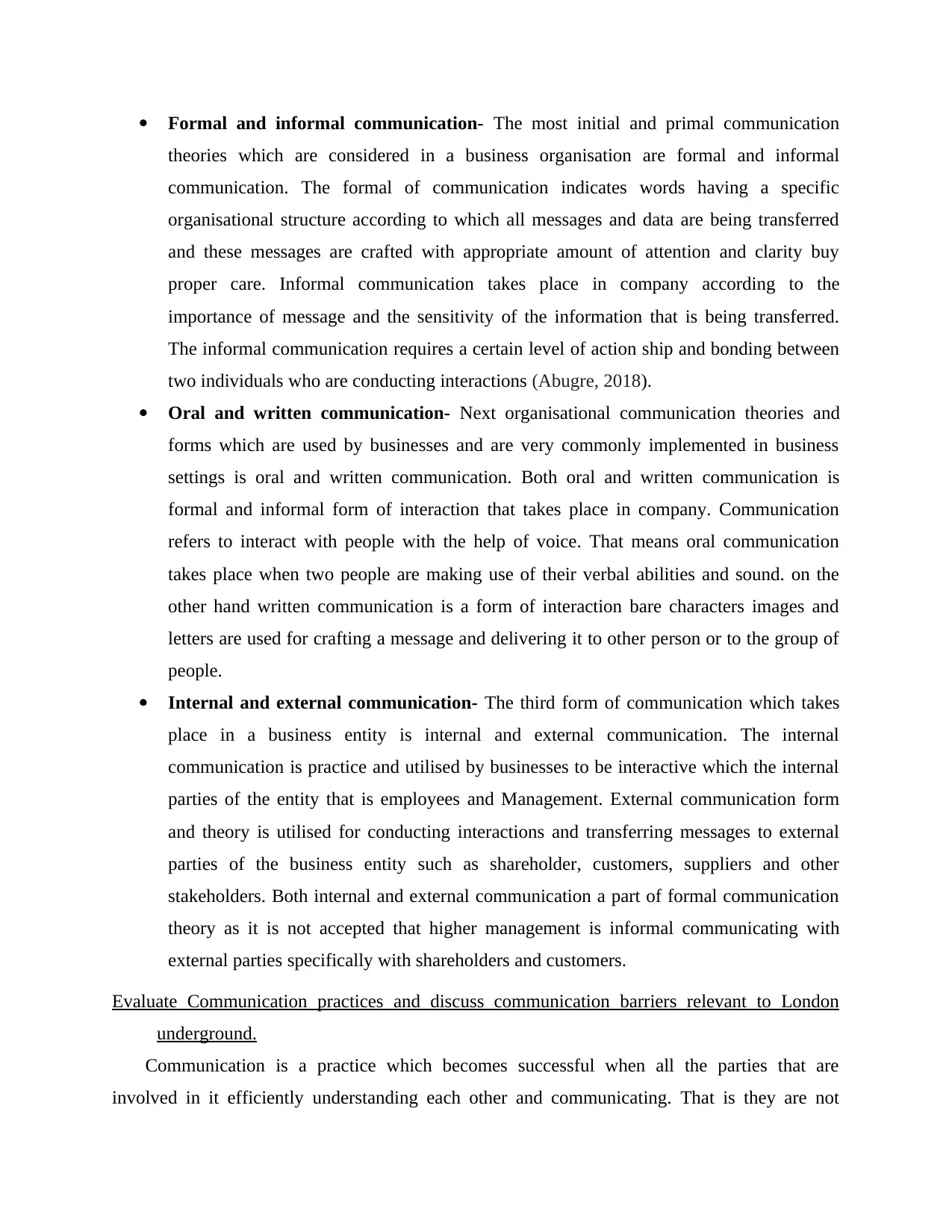
Formal and informal communication- The most initial and primal communication
theories which are considered in a business organisation are formal and informal
communication. The formal of communication indicates words having a specific
organisational structure according to which all messages and data are being transferred
and these messages are crafted with appropriate amount of attention and clarity buy
proper care. Informal communication takes place in company according to the
importance of message and the sensitivity of the information that is being transferred.
The informal communication requires a certain level of action ship and bonding between
two individuals who are conducting interactions (Abugre, 2018).
Oral and written communication- Next organisational communication theories and
forms which are used by businesses and are very commonly implemented in business
settings is oral and written communication. Both oral and written communication is
formal and informal form of interaction that takes place in company. Communication
refers to interact with people with the help of voice. That means oral communication
takes place when two people are making use of their verbal abilities and sound. on the
other hand written communication is a form of interaction bare characters images and
letters are used for crafting a message and delivering it to other person or to the group of
people.
Internal and external communication- The third form of communication which takes
place in a business entity is internal and external communication. The internal
communication is practice and utilised by businesses to be interactive which the internal
parties of the entity that is employees and Management. External communication form
and theory is utilised for conducting interactions and transferring messages to external
parties of the business entity such as shareholder, customers, suppliers and other
stakeholders. Both internal and external communication a part of formal communication
theory as it is not accepted that higher management is informal communicating with
external parties specifically with shareholders and customers.
Evaluate Communication practices and discuss communication barriers relevant to London
underground.
Communication is a practice which becomes successful when all the parties that are
involved in it efficiently understanding each other and communicating. That is they are not
theories which are considered in a business organisation are formal and informal
communication. The formal of communication indicates words having a specific
organisational structure according to which all messages and data are being transferred
and these messages are crafted with appropriate amount of attention and clarity buy
proper care. Informal communication takes place in company according to the
importance of message and the sensitivity of the information that is being transferred.
The informal communication requires a certain level of action ship and bonding between
two individuals who are conducting interactions (Abugre, 2018).
Oral and written communication- Next organisational communication theories and
forms which are used by businesses and are very commonly implemented in business
settings is oral and written communication. Both oral and written communication is
formal and informal form of interaction that takes place in company. Communication
refers to interact with people with the help of voice. That means oral communication
takes place when two people are making use of their verbal abilities and sound. on the
other hand written communication is a form of interaction bare characters images and
letters are used for crafting a message and delivering it to other person or to the group of
people.
Internal and external communication- The third form of communication which takes
place in a business entity is internal and external communication. The internal
communication is practice and utilised by businesses to be interactive which the internal
parties of the entity that is employees and Management. External communication form
and theory is utilised for conducting interactions and transferring messages to external
parties of the business entity such as shareholder, customers, suppliers and other
stakeholders. Both internal and external communication a part of formal communication
theory as it is not accepted that higher management is informal communicating with
external parties specifically with shareholders and customers.
Evaluate Communication practices and discuss communication barriers relevant to London
underground.
Communication is a practice which becomes successful when all the parties that are
involved in it efficiently understanding each other and communicating. That is they are not

facing any challenges while interacting with one another. There are numerous communication
barriers exist which hinders the purpose and prospective of a conversation that is being
performed in different parties (Setiawan and et. al., 2018). This is the problem which takes to
buy Londoners and tourist while travelling with one another in London underground tube. There
were several communication barriers which were hindering their conversations and creating
distress amongst the people leading towards challenges and issues amongst them. Few
Communication barriers which evident and easily recognisable amongst Londoners and tourist
are elaborated underneath:
Emotional barrier- The emotional barriers states that the people who are part of a
conversation are holding different emotional perspectives and their ideas behind
interacting with one another are separate. For instance, in London tube domestic
Londoners were travelling to reach other work please on time or you come back home
from their offices. On the other hand The tourist were travelling for exploring and
enjoying their vacations. This emotional barrier was present while two parties
communicated with one another and which hindered their objectives of interactions
(Cardon, Huang and Power, 2019).
Language barrier- The world is a huge platform holding numerous people, countries,
regions and relations. This implies that there are numerous languages present in the world
which are known and spoken by some but for others it is understandable. The language
barrier is another communication challenge which was faced by Londoners and tourist
while travelling in the tube. Few of the tourists was another of the language and few
Londoners were unaware of the language spoken by the tourist. This language difference
cost huge misunderstanding and distress in conversations that were taken place between
people as they were unable to understand each other for their actions which caused
misunderstanding and miscommunication.
RECOMMENDATIONS
Apply principles of effective communication to improve practices. Identify and include strategies
to overcome barriers relevant to London underground.
Londoners and tourist facing huge differences and barriers while communicating with one
another as these obstacles word creating harmful impacts and hindering the purpose of
barriers exist which hinders the purpose and prospective of a conversation that is being
performed in different parties (Setiawan and et. al., 2018). This is the problem which takes to
buy Londoners and tourist while travelling with one another in London underground tube. There
were several communication barriers which were hindering their conversations and creating
distress amongst the people leading towards challenges and issues amongst them. Few
Communication barriers which evident and easily recognisable amongst Londoners and tourist
are elaborated underneath:
Emotional barrier- The emotional barriers states that the people who are part of a
conversation are holding different emotional perspectives and their ideas behind
interacting with one another are separate. For instance, in London tube domestic
Londoners were travelling to reach other work please on time or you come back home
from their offices. On the other hand The tourist were travelling for exploring and
enjoying their vacations. This emotional barrier was present while two parties
communicated with one another and which hindered their objectives of interactions
(Cardon, Huang and Power, 2019).
Language barrier- The world is a huge platform holding numerous people, countries,
regions and relations. This implies that there are numerous languages present in the world
which are known and spoken by some but for others it is understandable. The language
barrier is another communication challenge which was faced by Londoners and tourist
while travelling in the tube. Few of the tourists was another of the language and few
Londoners were unaware of the language spoken by the tourist. This language difference
cost huge misunderstanding and distress in conversations that were taken place between
people as they were unable to understand each other for their actions which caused
misunderstanding and miscommunication.
RECOMMENDATIONS
Apply principles of effective communication to improve practices. Identify and include strategies
to overcome barriers relevant to London underground.
Londoners and tourist facing huge differences and barriers while communicating with one
another as these obstacles word creating harmful impacts and hindering the purpose of
⊘ This is a preview!⊘
Do you want full access?
Subscribe today to unlock all pages.

Trusted by 1+ million students worldwide
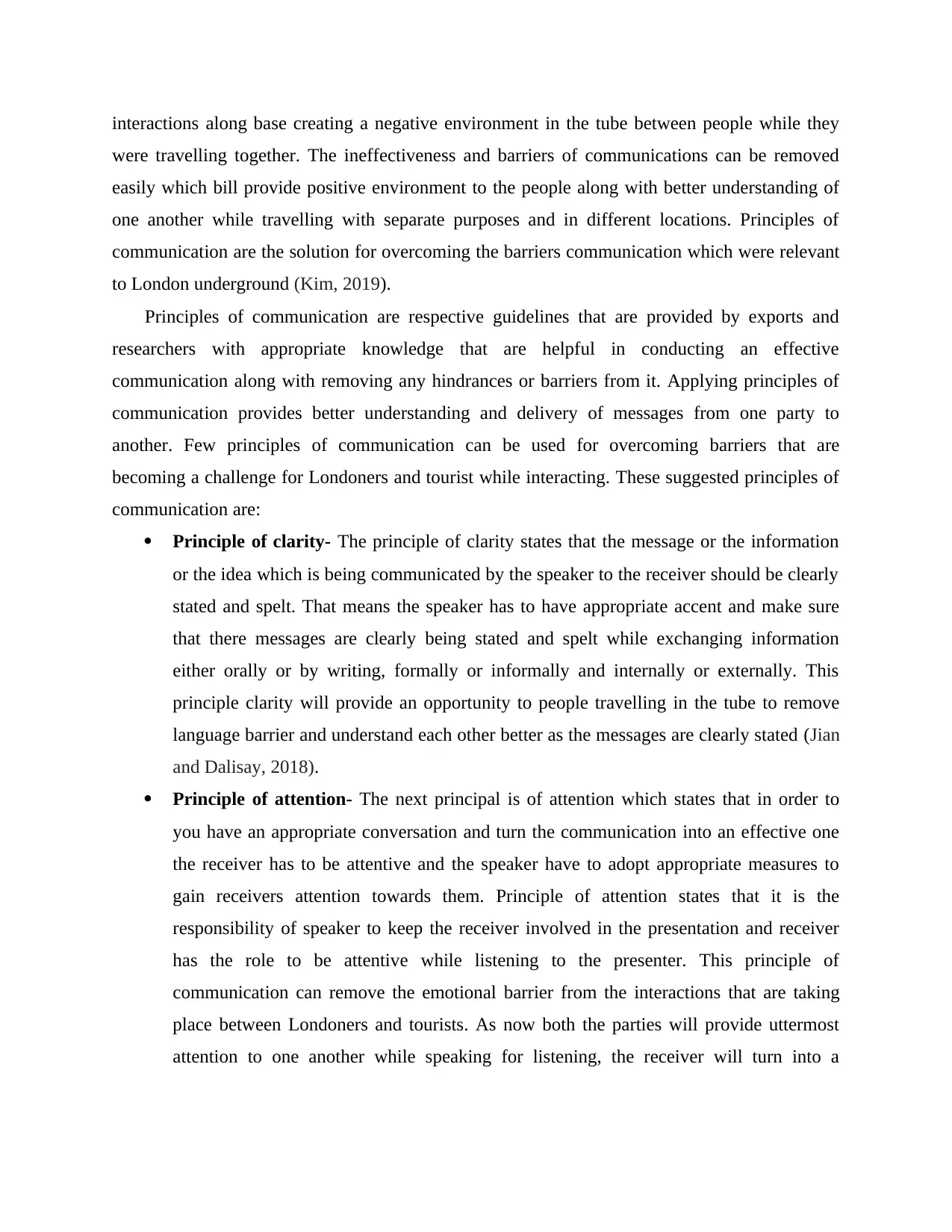
interactions along base creating a negative environment in the tube between people while they
were travelling together. The ineffectiveness and barriers of communications can be removed
easily which bill provide positive environment to the people along with better understanding of
one another while travelling with separate purposes and in different locations. Principles of
communication are the solution for overcoming the barriers communication which were relevant
to London underground (Kim, 2019).
Principles of communication are respective guidelines that are provided by exports and
researchers with appropriate knowledge that are helpful in conducting an effective
communication along with removing any hindrances or barriers from it. Applying principles of
communication provides better understanding and delivery of messages from one party to
another. Few principles of communication can be used for overcoming barriers that are
becoming a challenge for Londoners and tourist while interacting. These suggested principles of
communication are:
Principle of clarity- The principle of clarity states that the message or the information
or the idea which is being communicated by the speaker to the receiver should be clearly
stated and spelt. That means the speaker has to have appropriate accent and make sure
that there messages are clearly being stated and spelt while exchanging information
either orally or by writing, formally or informally and internally or externally. This
principle clarity will provide an opportunity to people travelling in the tube to remove
language barrier and understand each other better as the messages are clearly stated (Jian
and Dalisay, 2018).
Principle of attention- The next principal is of attention which states that in order to
you have an appropriate conversation and turn the communication into an effective one
the receiver has to be attentive and the speaker have to adopt appropriate measures to
gain receivers attention towards them. Principle of attention states that it is the
responsibility of speaker to keep the receiver involved in the presentation and receiver
has the role to be attentive while listening to the presenter. This principle of
communication can remove the emotional barrier from the interactions that are taking
place between Londoners and tourists. As now both the parties will provide uttermost
attention to one another while speaking for listening, the receiver will turn into a
were travelling together. The ineffectiveness and barriers of communications can be removed
easily which bill provide positive environment to the people along with better understanding of
one another while travelling with separate purposes and in different locations. Principles of
communication are the solution for overcoming the barriers communication which were relevant
to London underground (Kim, 2019).
Principles of communication are respective guidelines that are provided by exports and
researchers with appropriate knowledge that are helpful in conducting an effective
communication along with removing any hindrances or barriers from it. Applying principles of
communication provides better understanding and delivery of messages from one party to
another. Few principles of communication can be used for overcoming barriers that are
becoming a challenge for Londoners and tourist while interacting. These suggested principles of
communication are:
Principle of clarity- The principle of clarity states that the message or the information
or the idea which is being communicated by the speaker to the receiver should be clearly
stated and spelt. That means the speaker has to have appropriate accent and make sure
that there messages are clearly being stated and spelt while exchanging information
either orally or by writing, formally or informally and internally or externally. This
principle clarity will provide an opportunity to people travelling in the tube to remove
language barrier and understand each other better as the messages are clearly stated (Jian
and Dalisay, 2018).
Principle of attention- The next principal is of attention which states that in order to
you have an appropriate conversation and turn the communication into an effective one
the receiver has to be attentive and the speaker have to adopt appropriate measures to
gain receivers attention towards them. Principle of attention states that it is the
responsibility of speaker to keep the receiver involved in the presentation and receiver
has the role to be attentive while listening to the presenter. This principle of
communication can remove the emotional barrier from the interactions that are taking
place between Londoners and tourists. As now both the parties will provide uttermost
attention to one another while speaking for listening, the receiver will turn into a
Paraphrase This Document
Need a fresh take? Get an instant paraphrase of this document with our AI Paraphraser
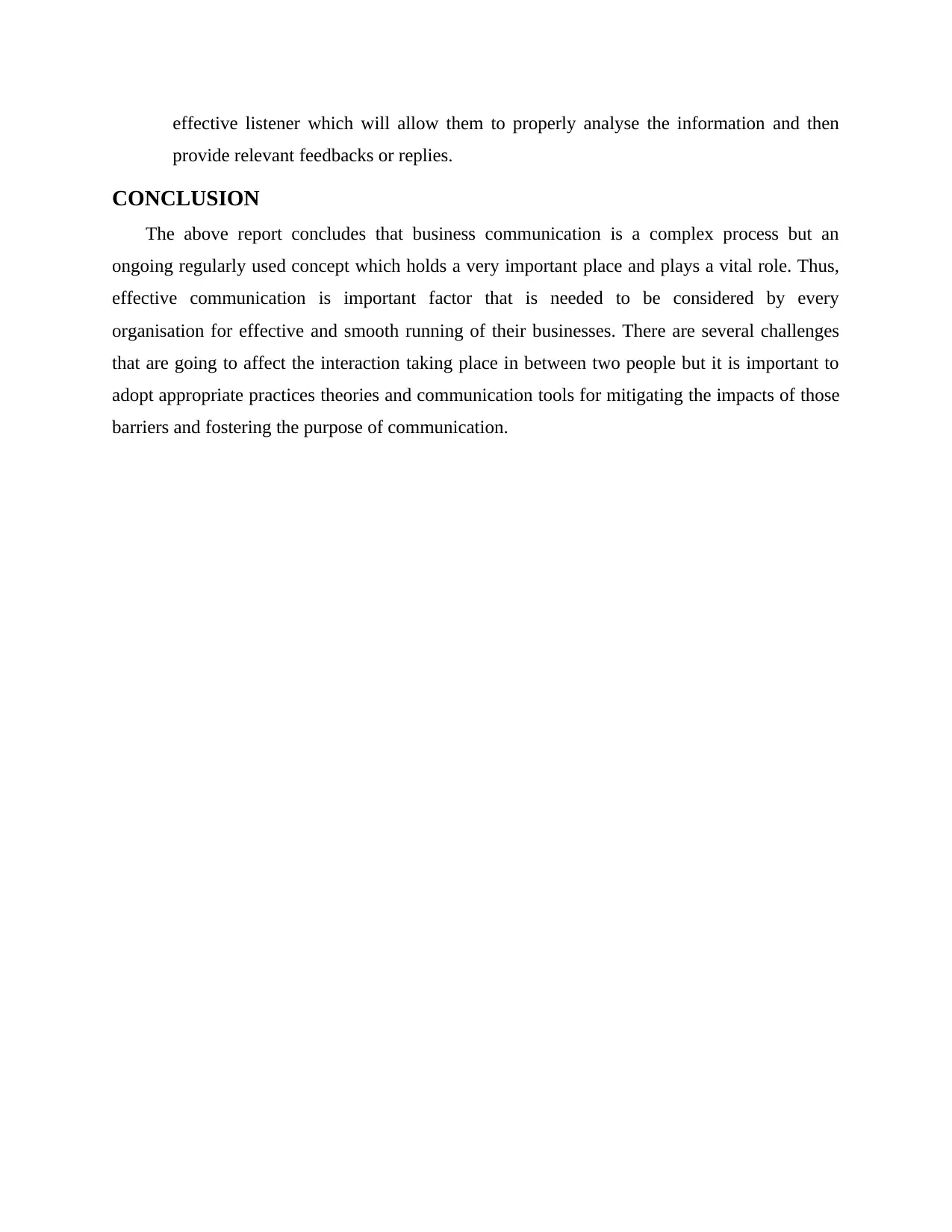
effective listener which will allow them to properly analyse the information and then
provide relevant feedbacks or replies.
CONCLUSION
The above report concludes that business communication is a complex process but an
ongoing regularly used concept which holds a very important place and plays a vital role. Thus,
effective communication is important factor that is needed to be considered by every
organisation for effective and smooth running of their businesses. There are several challenges
that are going to affect the interaction taking place in between two people but it is important to
adopt appropriate practices theories and communication tools for mitigating the impacts of those
barriers and fostering the purpose of communication.
provide relevant feedbacks or replies.
CONCLUSION
The above report concludes that business communication is a complex process but an
ongoing regularly used concept which holds a very important place and plays a vital role. Thus,
effective communication is important factor that is needed to be considered by every
organisation for effective and smooth running of their businesses. There are several challenges
that are going to affect the interaction taking place in between two people but it is important to
adopt appropriate practices theories and communication tools for mitigating the impacts of those
barriers and fostering the purpose of communication.
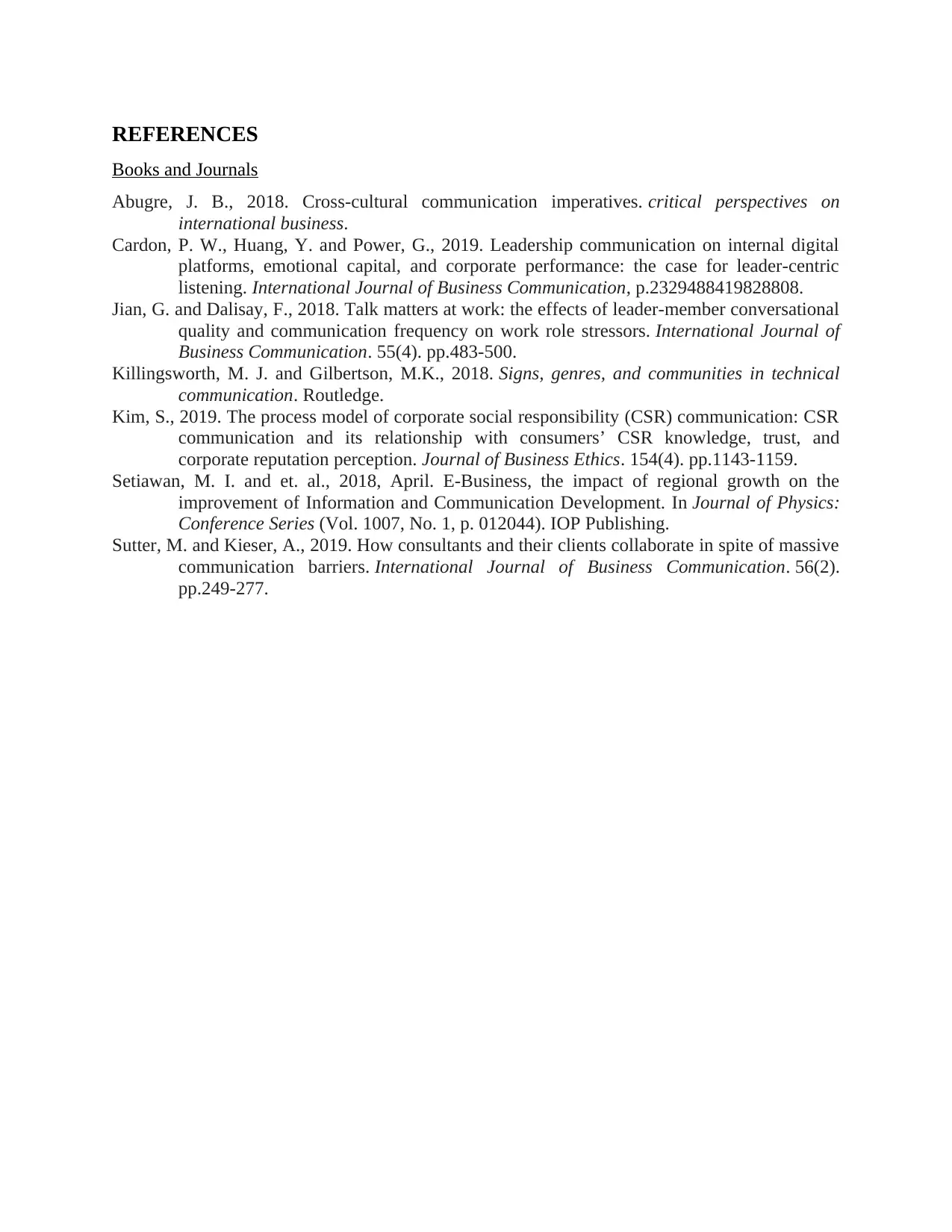
REFERENCES
Books and Journals
Abugre, J. B., 2018. Cross-cultural communication imperatives. critical perspectives on
international business.
Cardon, P. W., Huang, Y. and Power, G., 2019. Leadership communication on internal digital
platforms, emotional capital, and corporate performance: the case for leader-centric
listening. International Journal of Business Communication, p.2329488419828808.
Jian, G. and Dalisay, F., 2018. Talk matters at work: the effects of leader-member conversational
quality and communication frequency on work role stressors. International Journal of
Business Communication. 55(4). pp.483-500.
Killingsworth, M. J. and Gilbertson, M.K., 2018. Signs, genres, and communities in technical
communication. Routledge.
Kim, S., 2019. The process model of corporate social responsibility (CSR) communication: CSR
communication and its relationship with consumers’ CSR knowledge, trust, and
corporate reputation perception. Journal of Business Ethics. 154(4). pp.1143-1159.
Setiawan, M. I. and et. al., 2018, April. E-Business, the impact of regional growth on the
improvement of Information and Communication Development. In Journal of Physics:
Conference Series (Vol. 1007, No. 1, p. 012044). IOP Publishing.
Sutter, M. and Kieser, A., 2019. How consultants and their clients collaborate in spite of massive
communication barriers. International Journal of Business Communication. 56(2).
pp.249-277.
Books and Journals
Abugre, J. B., 2018. Cross-cultural communication imperatives. critical perspectives on
international business.
Cardon, P. W., Huang, Y. and Power, G., 2019. Leadership communication on internal digital
platforms, emotional capital, and corporate performance: the case for leader-centric
listening. International Journal of Business Communication, p.2329488419828808.
Jian, G. and Dalisay, F., 2018. Talk matters at work: the effects of leader-member conversational
quality and communication frequency on work role stressors. International Journal of
Business Communication. 55(4). pp.483-500.
Killingsworth, M. J. and Gilbertson, M.K., 2018. Signs, genres, and communities in technical
communication. Routledge.
Kim, S., 2019. The process model of corporate social responsibility (CSR) communication: CSR
communication and its relationship with consumers’ CSR knowledge, trust, and
corporate reputation perception. Journal of Business Ethics. 154(4). pp.1143-1159.
Setiawan, M. I. and et. al., 2018, April. E-Business, the impact of regional growth on the
improvement of Information and Communication Development. In Journal of Physics:
Conference Series (Vol. 1007, No. 1, p. 012044). IOP Publishing.
Sutter, M. and Kieser, A., 2019. How consultants and their clients collaborate in spite of massive
communication barriers. International Journal of Business Communication. 56(2).
pp.249-277.
⊘ This is a preview!⊘
Do you want full access?
Subscribe today to unlock all pages.

Trusted by 1+ million students worldwide
1 out of 9
Related Documents
Your All-in-One AI-Powered Toolkit for Academic Success.
+13062052269
info@desklib.com
Available 24*7 on WhatsApp / Email
![[object Object]](/_next/static/media/star-bottom.7253800d.svg)
Unlock your academic potential
Copyright © 2020–2025 A2Z Services. All Rights Reserved. Developed and managed by ZUCOL.





